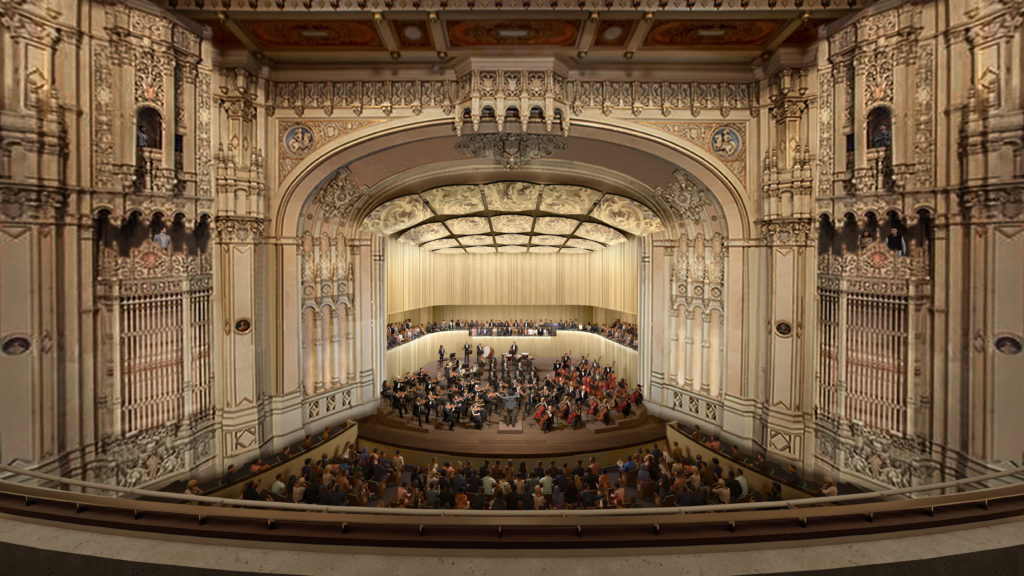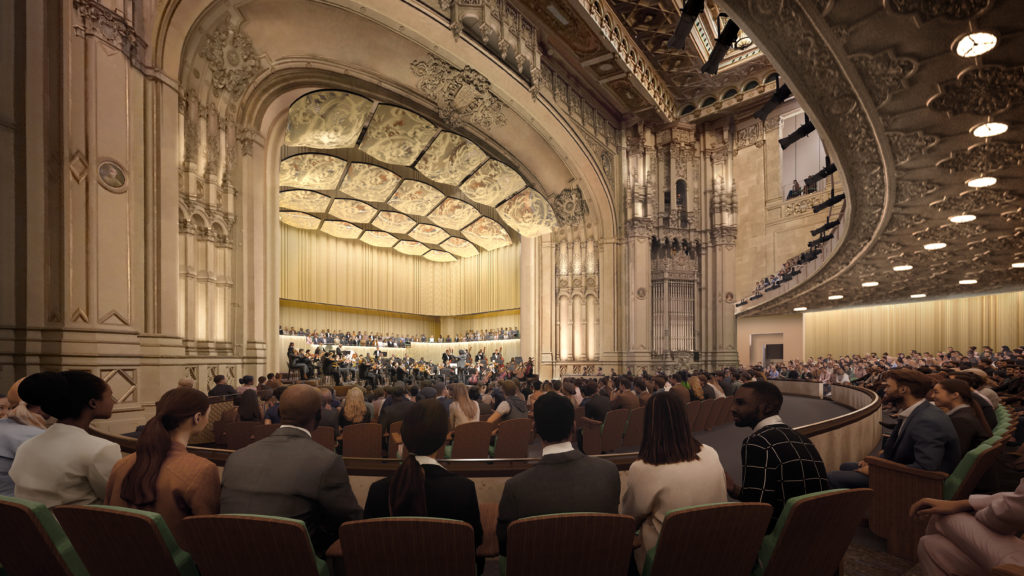San Diego Symphony Announces $125 Million Renovation of the Jacobs Music Center
In a press conference Wednesday morning held at the Jacobs Music Center in downtown San Diego, leaders of the San Diego Symphony announced a $125 million renovation of Copley Symphony Hall and adjacent sections of the Jacobs Music Center.

Proposed new stage configuration with choral parterre and overhead acoustical reflectors [image (c.) San Diego Symphony and HGA]
In 1986, the San Diego Symphony acquired the historic Fox Theater building at Seventh and B Streets and restored the aging 2000-plus seat movie house with modest alterations to provide a concert venue for the orchestra. While audiences have appreciated the ornate decor of the hall’s Spanish Baroque movie palace interiors, a major drawback has been the hall’s disappointing, uneven acoustics. Under the direction of Rafael Payare, who became Music Director in 2019, the orchestra has improved significantly.
With its sophisticated sound system, The Rady Shell at Jacobs Park—the Symphony’s impressive new outdoor venue that opened in August of 2021—has demonstrated the Symphony’s increased interpretive artistry and sonic prowess.
“We have already see the impact of The Rady Shell at Jacobs Park on our musicians, our audiences, and the people of San Diego,” noted Rafael Payere. “To have the opportunity to improve the beautiful hall we call home and to improve the musical communication on stage with the musicians, as well as to create a more intimate connection with our audiences is a fantastic dream.”
Realizing this dream is the responsibility of a team: the architectural firm HGA, the acousticians of Akustics, and theater planners Schuler Shook.
John Frane, Design Principal of HGA, outlined the project’s extensive renovation laundry list, which includes enhanced stage lighting, a completely new and quieter HVAC system, all new seating throughout the hall, an improved sound system, and an integrated video display system.
But he made it clear that “correcting the acoustics of the hall” is the top priority, and that will require some significant structural changes. The most significant change will be permanent alterations to the stage itself.
“The current movable shell will be replaced by a permanent, fixed stage enclosure with twenty tunable acoustical reflectors placed at the top of the stage area,” said Frane. They will also construct a “choral terrace” placed slightly above the players along the back and sides of the stage enclosure; this will seat up to 75 singers and will allow the orchestra to present large choral oratorios as well as symphonic repertory that calls for chorus. When no chorus is needed, this will allow additional audience seating, an architectural accommodation for choirs and audience members that is a successful part of the design of Disney Concert Hall in Los Angeles.

New main floor configuration with semi-circular seating backed by acoustic screen [image (c.) San Diego Symphony and HGA]
Frane said that with some modest additions to side balcony seating upstairs, the total seating capacity of the renovated hall would be 1750.
This sound screen, which Frane said his firm has successfully used in other concert hall renovations, has three components. The screen itself is a visually attractive sound-permeable metal mesh; behind the screen is a hard reflecting wall that gives the room brighter, live acoustics, as well as a sound absorptive curtain that can be lowered between the mesh and the wall to make the room less acoustically live, a characteristic prized for highly amplified concert presentations.
In his opening remarks yesterday, Symphony Board of Directors Chair Harold Fuson, Jr. stated, “This transformation of the Symphony’s home, however, will respect both the history and aesthetics of the hall.”
A brief tour of Copley Symphony Hall after the conference revealed that the preparations for renovation had already commenced, with all of the audience seating removed and the stage area stripped back to its structural skeleton.
“We intend to complete this renovation by the fall of 2023,” said Gilmer, adding that an explanation of the funding process for this renovation project would be revealed at a later time.
The San Diego Symphony press conference was held at the Jacobs Music Center on Wednesday, February 23, 2022.

Ken Herman, a classically trained pianist and organist, has covered music for the San Diego Union, the Los Angeles Times’ San Diego Edition, and for sandiego.com. He has won numerous awards, including first place for Live Performance and Opera Reviews in the 2017, the 2018, and the 2019 Excellence in Journalism Awards competition held by the San Diego Press Club. A Chicago native, he came to San Diego to pursue a graduate degree and stayed.Read more…
